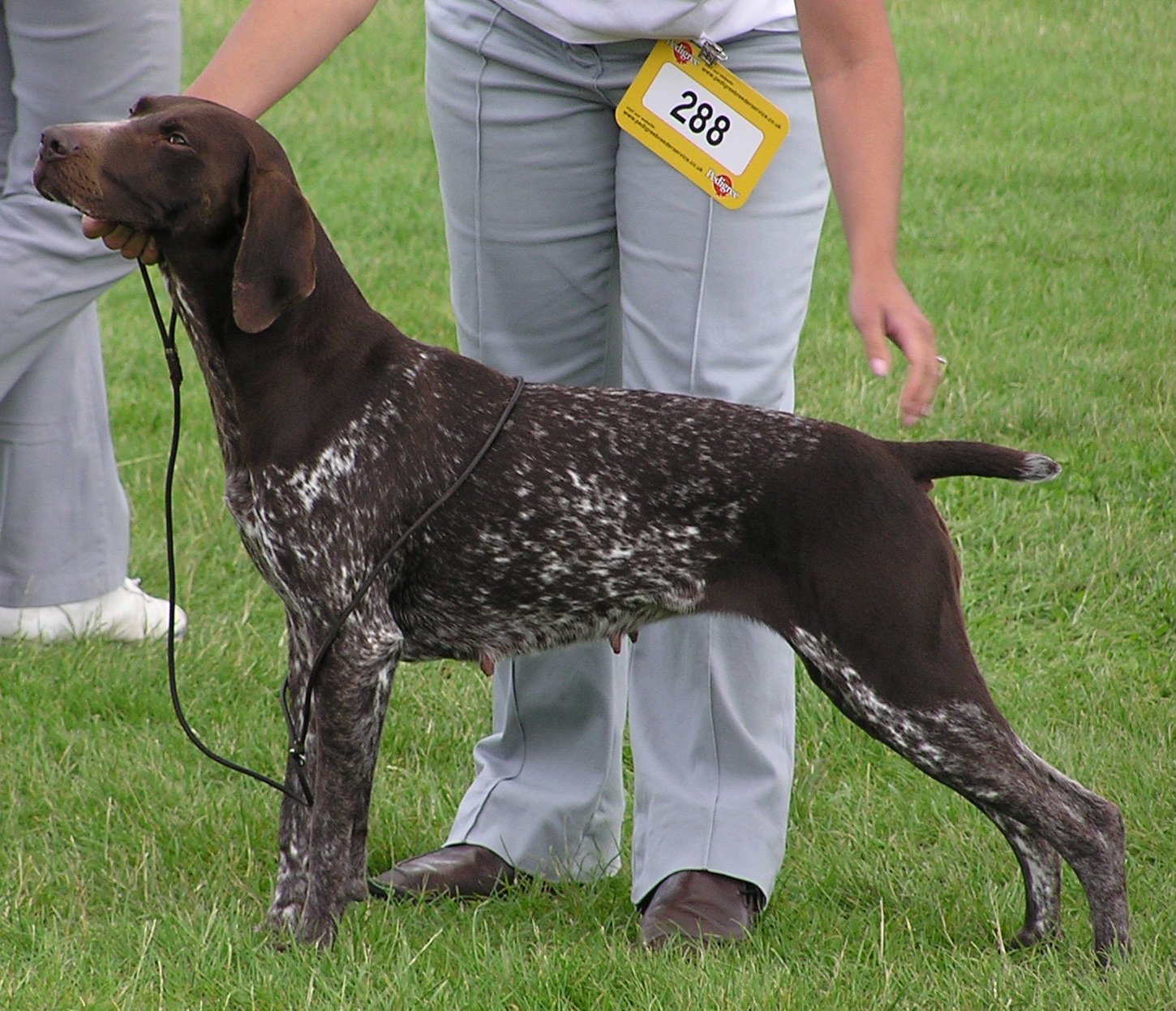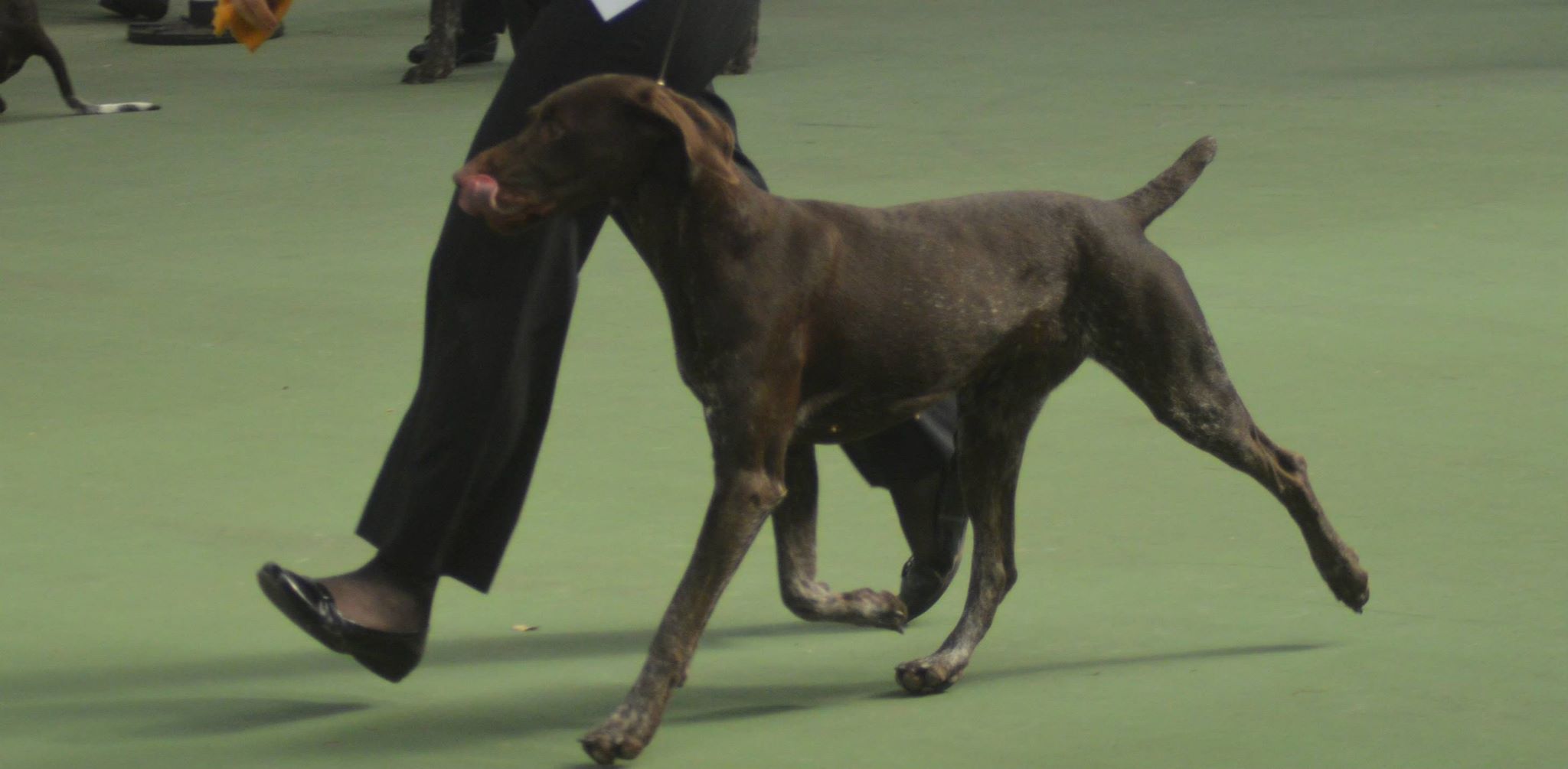An Interview With Show Dog Owner, Charlotte Tudor
17/08/2015
We’ve a bit of a change from our usual articles this time around, but we thought our readers might appreciate an opportunity to hear directly from a canine professional – namely, passionate show entrant and breeder, Charlotte Tudor. Charlotte very kindly agreed to be interviewed about the hard work involved in showing dogs, but also what it feels like to be a winner.
Hi Charlotte, thank you for agreeing to chat to Gilbertson & Page about your experiences showing dogs. Please could you start by telling us a little about the dogs that you own and which ones you show?
We currently own two (very beautiful) German Shorthaired Pointers; Parsley is mum to Pepper and they are aged seven years and two years respectively. We also own a Miniature Schnauzer called Inca who is our little golden oldie at eleven years. Parsley and Pepper are shown regularly.
There must be a huge amount of work that goes into training a dog for showing. How many hours do you put in per week/month approximately?
Wow, that’s a tough question, I’m not sure I can answer accurately. An incredible amount of work goes into training a dog for the show ring and sometimes getting your dog to perform in the ring is often a lot harder than it looks. It’s not only the dog that needs to learn – it’s the handler too. I have shown five different dogs over the years and each one has been handled differently depending upon the trait and quirks of the dog. The main aim is to present your dog to show off their finer points. You must work hard with your dog to build up an excellent rapport between the two of you – the dog needs to focus on you and not be easily distracted by other things going on around them. Your dog needs to be well socialised as it will come into close contact with lots of other people and dogs and be incredibly patient as well – there can be a lot of waiting around both in the ring and out. Most importantly your dog must enjoy the experience – a dog that is shy or ambles around the ring will not impress the judge.
Are you a member of a regional or local ringcraft club? Could you describe what goes on at a meeting for our readers?
There are lots of local ringcraft clubs all over the country. The Kennel Club hold details of local clubs where you can train your dog. A Ringcraft class is for training you how to handle your dog to present it in front of a judge to show off your dog’s best attributes. At first an experienced handler will help you to learn how ‘stack’ your dog so that a judge can check over your dog’s conformation. The handler will then show you how to ‘run’ your dog, again to show off its conformation to the judge (Judged against the Kennel Club breed standard for the dog). When you become familiar with what you are trying to achieve, the ringcraft class is basically a place to practice. Experienced handlers take on the role of the judge and ‘go over’ their dog as a judge would in the show ring.
As you know, at Gilbertson & Page we manufacture premium dog food that provides a nutritionally-balanced diet to keep a dog in the best condition. How important would you say a good diet is when you own show dogs? Do you favour particular supplements within the formula or as an addition to their normal food? And if so, which supplements do you find particularly beneficial?
A good diet is extremely important when showing dogs as you need your dog to always look in tip top condition. We add salmon oil to our dog’s food, as it helps to maintain a great coat!
How do you prepare for show day? Are there any tricks of the trade that you employ in those vital last few days or hours before a show?
Your dog always needs to be in perfect condition whilst showing; our German Pointers are a shortcoated breed with everything on show – there is nowhere to hide with these dogs. The weight and coat condition are of paramount importance here. If our dogs are looking a little overweight or underweight we adjust the amount of food/exercise accordingly. We also make sure that the dogs’ nails are clipped – long nails can affect how the foot looks! We take a leather chamois cloth to ‘polish’ our dogs’ coats – so they look super shiny and healthy in the ring.
People that show coated breeds would need to trim and wash their dogs and keep them clean in the days/hours preceding a show – you often see dogs at shows with bibs, boots and or snoods to keep them clean!
What happens on show day? Would you mind giving a quick run-down of the order of events and what happens in the ring itself?
There are different types of show. We attend Open and Championship Shows. Open shows are run by local clubs and are a smaller show than a Championship show which are held over a number of days and covers all breeds and groups. Championship shows are held all over the country and I regularly travel as far as South Wales, Paignton and Edinburgh from the north east of England.
It’s always an early start as generally judging commences at around 9am. When you arrive at a show you need to show your exhibitor’s pass to enter the showground. At Championship shows all dogs are ‘benched’ which means that a steel/wooden structure is provided by the show – this is where your dog is kept for the day unless it is in the ring or being exercised.
When it is time for your class, the normal procedure is for all dogs to enter the ring and stand in a line. The judge will sometimes ask the first exhibitor to lead all exhibitors around the ring so that they can make their first assessment of the dogs in the class. The judge will then examine each dog at the judge’s table. The judge will then ask you to move your dog, usually by running it in a triangle shape so that they can get a view of the dogs back, front and side movement (gait). When the last dog has been judged you need to have your dog stacked and looking its best for the judge to make their final decision. The judge will then place 5 dogs, 1st, 2nd 3rd etc.
When all the classes of one sex have been judged the unbeaten winning dogs will be called back into the ring to challenge for best dog or best bitch and the much-coveted Challenge Certificate (ticket or CC). This is a certificate which the judge signs stating that in their opinion the dog is worthy of becoming a show champion. You need to win three CC’s for your dog to gain its ‘SH CH’ (Show Champion) title. The best dog and the best bitch will then compete for best of breed. This exhibit is the dog that would enter the group and be judged against all the other best of breed winners in that group. There are seven groups of dogs (gundog, terrier, hound, utility, working, pastoral and toy). Finally the seven group winners will compete for the prestigious Best in Show title.
How does it feel when you win a prize at a dog show?
It’s great when the culmination of hard work pays off and you are awarded a card and rosette. There is a lot of stiff competition out there but show people say, ‘You always take the best dog home with you whatever the outcome!’
Thanks again, Charlotte. I’m sure our readers will really enjoy reading about your experiences and good luck with your next show!




